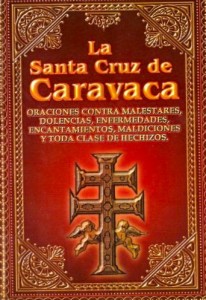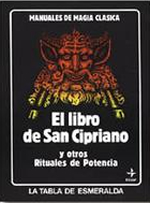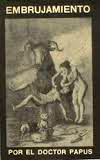 |
| Don Julio Gerena Pinedo, at the age of 89, with his book of spells |
Look carefully at the picture on the right of the 89-year-old Don Julio Gerena Pinedo sitting before his mesa, with his ritual implements in front of him — ayahuasca, agua de florida, camalonga, a shacapa, and a book. The book is a book of prayers and protections.
Most mestizo shamans will tell you they are Catholic, and they are probably about as Catholic as most mestizos living in the Amazon. More than 80 percent of Peruvians say they are Roman Catholic. The Peruvian constitution recognizes Roman Catholicism as deserving of government cooperation; public schools offer mandatory classes in Catholic religion, from which non-Catholic parents must request an exemption in writing from the school principal.
This is not to deny that evangelical Protestantism has made significant inroads into Catholic hegemony. There are now estimated to be around 1.5 million members of evangelical churches in Peru. In many rural villages, while the Catholic church is left locked, the Jehovah’s Witnesses or Mormons or Adventists or some other non-Catholic denomination has set up a prayer group and a meeting house.
And there are also some not-so-subtle anticlerical attitudes among the ribereños. A popular toy is a carving of a Franciscan monk in a robe; pulling on a string lifts up the robe, and a large erect penis pops up, like a jack-in-the-box. People think this is hilarious. In the small ribereño villages along the jungle waterways, I am told, a priest will appear once or twice a year and hastily perform marriage ceremonies for all the cohabiting couples.
Still, Roman Catholicism remains a singularly powerful cultural force. For example, in Iquitos, people will organize a velada — a ritual celebration in honor of a saint — or will arrange for a misa de honras, a memorial mass, to ask for protection from tunchis or malignos, the spirits of the dead.
 |
This folk Catholicism manifests itself in many ways. Good luck charms, for example, often containing images of saints, may be carried or placed on small altars in the home. Among mestizo shamans, folk Catholicism manifests itself primarily in two ways — first, in viewing Jesus Christ and the Virgin Mary as particularly powerful healing and protecting spirits; and, second, in using books of prayers and protections to remove evil and to ensure safety.
A popular spell book is The Sacred Cross of Caravaca, which provides a number of lengthy prayers to various saints as well as oraciones curativas, brief prayers and spells for healing. “Tests repeated a thousand times,” says the anonymous author, “have given us the absolute conviction of their efficacy; thousands of impartial and careful testimonials agree with us in proclaiming their value in every case.” For example, a prayer against burns: “Fire is not cold. Water is not thirsty. Air is not hot. Bread is not hungry. San Lorenzo, cure these burns, by the power God has given you.” Against cataracts: “Cataract, cataract, formed of blood and water; in honor and glory of the Holy Trinity, may it be quickly healed.” Again: “Mother of San Simeón, advocate against cataracts. Clear is the moon; clear is the sun; clear let the vision be of N., by your intercession.” And against a sore throat: “In Belén are three young girls: one sews, another spins, and another heals sore throats. One spins, another sews, and another heals sore throats.”
Interestingly, this folk Catholicism shades easily over into magia, magic. In the Upper Amazon, the term refers specifically to the magical power of white people, in distinction to the power of indigenous Amazonian shamans. It was their magia that allowed the whites to come and take over the land.
 |
This magic is found in books, particularly in grimorios such as the Book of San Cipriano or the Great Grimoire of Pope Honorius, and in Spanish translations of the texts of nineteenth-century European occultism. This means that books on magia can be purchased at the market and learned by oneself, without needing a maestro for protection and guidance, and without undergoing the training and suffering of sexual abstinence and the restricted diet. All you need do is buy the book and find the right spell.
But there is a price to pay. Some people say that the magic of the whites requires a pact with the devil. The prayers and spells in the books of magia can conjure up evil spirits who then harm the conjurer. My teacher doña María Tuesta told me that magic makes people cruzado, confused and burdened, because they have no guidance from a maestro. Buying magia in a bookstore requires no self-control; it is like dieting only long enough to become a brujo. To receive initiation from a shaman, one must undergo severe dietary, sexual, and other restrictions, but to become a magician one need only read a book oand follow its instructions. Being a magician is considered to involve less suffering, and to require less self-control, than being a healer.
 |
Here is an example of a magic spell from one version — there are many — of the Book of St. Cyprian, telling how a woman can make a man fall in love with her. The woman should get from the chosen man a coin, medal, pin, or other object, or part of an object, made of silver, which he has had with him for a period of twenty-four hours. She should approach the man holding the object in her right hand, and with the other hand offer him a cup of wine, in which she has dissolved a small pill, the size of a grain of millet, with the following composition — the head of an eel, a thimble-full of hemp seeds, two drops of laudanum, and six drops of her own blood, taken from her menstruation in the same month. As soon as the man has drunk the cup of wine with this mixture, he will fall helplessly in love with the woman who gave it to him.
Do not try this at home.

- Previous Post: Canaima
- Next Post: Selling Spirituality
- More Articles Related to: Shamanism



Michael Taussig wrote a fascinating passage about libros de magia in shamanism, colonialism and the wild man, well worth checking out.
The other interesting fact is that a variation on the cruz de Cuernavaca is used as one of the Santo Daime’s central symbols.
This is a very interesting blog! Congratulations